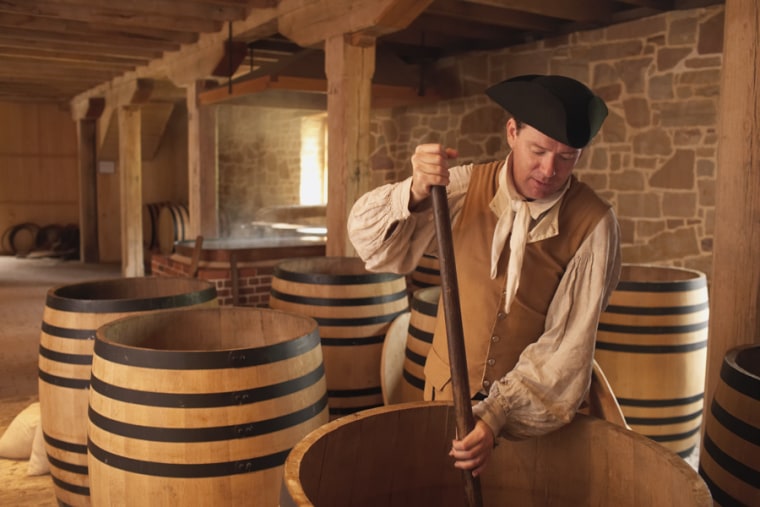Every year like clockwork, schoolchildren learn that young George Washington couldn’t tell a lie after chopping down a cherry tree. They’re taught that his under-manned American army trounced the mighty British, leading to his eventual election as America’s first president. But there's another story that few students—and even fewer adults—are ever told: After leaving the presidency in 1797 and retiring to Virginia’s Mount Vernon, Founding Father George Washington became one of America’s foremost whiskey manufacturers.
“Understanding that America’s first president became a successful whiskey distiller speaks volumes about liquor’s role in American history,” says Frank Coleman, senior vice president of the Distilled Spirits Council. “This should be of interest to all Americans.”
Look beyond the liquor bottle, and you’ll discover how spirits shape a region’s history, traditions and cuisine. From slurping Turkey’s licorice-flavored raki alongside feta cheese and melon to exploring sunny Martinique’s farm-fresh rum distilleries to perusing the spiky blue agave plants of Tequila, Mexico, spirit-based excursions provide a peek into a region’s culture—and an excuse to imbibe for education’s sake.
Start your, ahem, spiritual journeys with the American Whiskey Trail. “It’s not just about whiskey drinking; it’s about culture and heritage,” says Coleman. The trail includes spirits-related sites in New York, Pennsylvania, Virginia, Kentucky and Tennessee, but the gateway is George Washington’s recently rebuilt Mount Vernon whiskey concern, “which can demonstrate 18th-century distilling methods, from grain to barrel,” Coleman says.
From there, you can travel to Bardston, Kentucky’s Oscar Getz Museum of Whiskey History, which contains rare whiskey artifacts and even Abraham Lincoln’s liquor license. But “for a true sense of history,” Coleman suggests Maker’s Mark in Loretto, Kentucky. Established in 1805 as a gristmill distillery, this National Historic Landmark replicates a 19th-century village and doubles as an arboretum.
Since the 16th century, Caribbean distillers have recycled molasses—a byproduct of industrial sugar production—into rum. “It’s an economic lifeline for many Caribbean nations,” says Wayne Curtis, author of "And a Bottle of Rum." “However, nowadays sugarcane fields are more valuable as condo developments. In the Caribbean, rum is moving from industrial to boutique production.”
To investigate boutique rum production, Curtis recommends Martinique, home to a half-dozen distilleries. On the sandy, picturesque island, distilleries don’t mess with molasses. Instead, Martinique’s grassy, nuanced rhum agricole is crafted from locally harvested, fresh-pressed sugarcane juice—often processed within an hour after leaving fields. “This means the distilleries are granted an Appellation d’Origine Controlée by the French government, which means they can claim wine-like terroir,” Curtis says.
France itself offers several history-soaked potables (other than wine). The herbaceous, nearly 300-year-old Chartreuse is crafted by monks who smuggled the secret recipe to safety during the French Revolution, and is the only liquor to inspire a color. And Cognac forms the fiscal backbone of its eponymous western French region, in the Charente départment.
“Directly or indirectly, more than 50,000 people live by Cognac,” says Jérôme Durand, director of marketing and communication for the Bureau National Interprofessionnel du Cognac. The transformation of white wine into clear eau-de-vie liquor, then aged in wooden barrels until it becomes Cognac, provides the medieval town of Cognac with a pungent perfume.
“If you come during the wintertime when all the producers are distilling and walk around Cognac, you can smell a sweet, very specific scent: It’s Cognac in the air,” Durand says. Still, the preferred season for visiting is spring or summer, when you can tour vineyards, distilleries such as Hennessy and Courvoisier, cruise the serene Charente River or search out small, family-based producers.

“Knock on their door and they’ll say, ‘Come on inside.’” Durand says. “There’s a pleasant elegance and refined charm to this region.”
Rugged but no less charming liquor trips await in Scotland. The Malt Whisky Trail winds through the Scottish Highlands’ castles, cathedrals and distilleries like Glenlivet and Glenfiddich, and the Whiskey Coast is a jaunt down Scotland’s dramatic western coastline, interspersed with lush golf courses and well-known distilleries like Laphroaig.
If one country can match Scotland’s ardor for spirits, it’s tequila-mad Mexico. Last year, the Mexican government announced the creation of La Ruta del Tequila in the Jalisco state on the Pacific coast. The as-yet-unmapped route will include ancient archaeological sites, active and inactive distilleries and important tequila centers like Amatitlán and, naturally, Tequila.
“It’s been designated by the Mexican government as a pueblo mágico—a magical town,” says Anamaria Ceseña, senior brand manager of Jose Cuervo International. “The government said, ‘Let’s not lose this town’s charm.’ It remains like it was in the 1600s: The cobblestone streets are the same, and neon signs aren’t allowed.”
Tequila possesses postcard-pretty brick-and-adobe buildings, Cuervo’s and Sauza’s sun-bleached distilleries and nearby fields of tequila’s main ingredient, the tall, spiky blue agave succulent. These attractions have earned the region the ultimate praise: a United Nations Educational, Scientific and Cultural Organization World Heritage Site designation.
“That means Tequila is important to the world,” Ceseña says. “It truly is a magical town to visit.”
